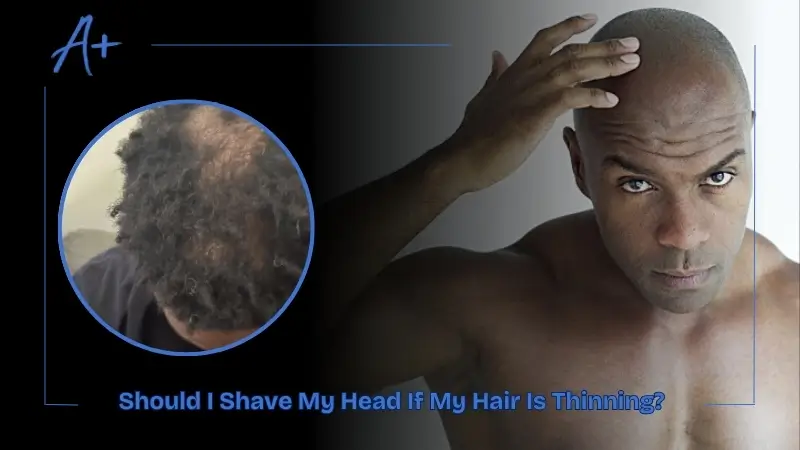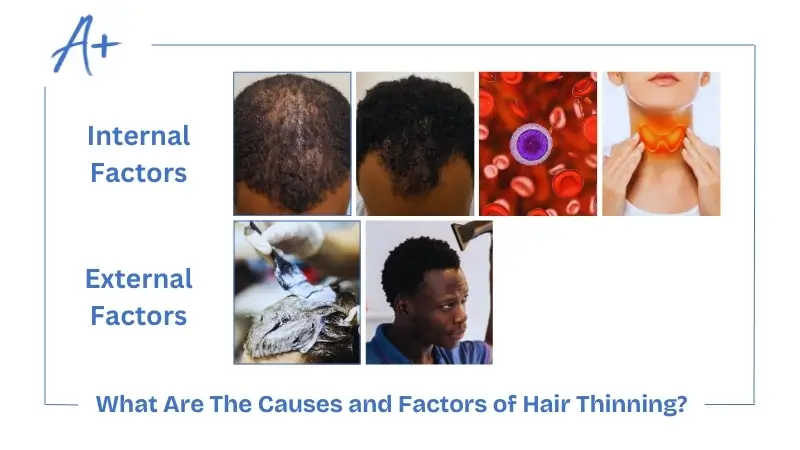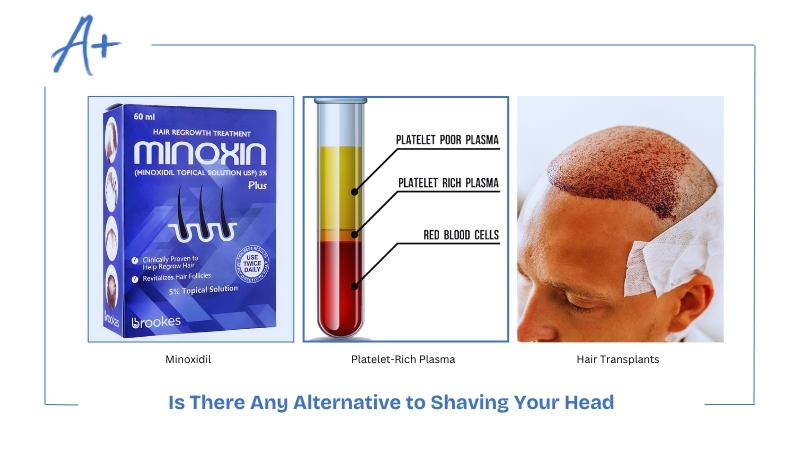If you’re experiencing thinning hair, the question “Should I shave my head?” may have crossed your mind. Hair loss can be emotionally challenging, affecting your self-image and confidence. It’s essential to understand that the decision to shave your head depends on several factors beyond just the degree of thinning.
Our specialists advise that it’s not solely about the appearance of thinning hair, but how it’s affecting your lifestyle, your mental health, and whether it’s linked to internal health conditions or external styling habits.
Shaving your head may be a liberating choice for some, offering freedom from constant styling anxiety and allowing a fresh start. However, it is important to consider both the psychological impact and long-term consequences before making this decision.


Internal Factors: Hormonal Imbalances and Health Conditions
Hair thinning can be caused by several internal factors, including hormonal imbalances, genetics, and underlying health conditions. Common causes include:
- Androgenic Alopecia: Also known as male-pattern baldness or female-pattern hair loss, it’s the most common cause of thinning hair, especially as you age. It is often genetic and can be inherited from either parent.
- Telogen Effluvium: This condition occurs when a large number of hair follicles prematurely enter the resting phase. It can result from stress, medication, or illness.
- Nutritional Deficiencies: A lack of essential nutrients like iron, biotin, and zinc can affect hair health.
- Thyroid Imbalance: Hypothyroidism and hyperthyroidism can lead to thinning hair as a symptom of the hormonal imbalance.
If your hair thinning is caused by any of these internal issues, shaving your head will not address the underlying cause. Our specialists recommend seeking treatment for the root cause before considering shaving.
External Factors: Chemical Damage and Styling Practices
In some cases, thinning hair is the result of external factors, including:
- Chemical Damage: Frequent use of harsh hair treatments such as relaxers, perms, or dyes can weaken hair and lead to breakage and thinning.
- Heat Styling: Excessive use of blow dryers, straighteners, and curling irons can damage hair strands, leading to thinning over time.
If your hair loss is related to styling habits, a trichologist or dermatologist may help you restore the health of your scalp and hair. In this case, shaving could help you transition to healthier hair, but it won’t solve the issue entirely if you continue using damaging styling practices.
Should You Shave Your Head? Weighing the Pros and Cons
When you notice your hair thinning, it’s easy to think that shaving might be the best solution. However, it’s important to consider the psychological effects, as well as the potential long-term consequences, before making this decision.

The Psychological Impact of Thinning Hair
Hair is an important part of our self-image and confidence. Thinning hair can significantly impact how we feel about ourselves, leading to stress, anxiety, and even social withdrawal. For some, the idea of thinning or receding hair can become an overwhelming concern.
If you’re constantly worrying about your appearance, avoiding activities, or feeling self-conscious, it might be time to consider whether shaving your head could help. Our surgeons and hair specialists suggest that, in some cases, the decision to shave is more about mental relief than improving the condition of the hair itself.
The Pros of Shaving Your Head
There are many advantages to shaving your head, especially if hair loss is affecting your life:
- Freedom from Anxiety: Shaving removes the stress of styling or hiding thinning patches. Many people find it liberating to embrace a clean-shaven head, letting go of the constant worry about their appearance.
- Boost in Confidence: A bold shaved look can be empowering. Embracing the shaved look can make you feel more in control of your image.
- Simplified Maintenance: With a shaved head, you eliminate the need for time-consuming styling, which can be a relief for those who are always trying to mask thinning areas.
Shaving your head can also help you make a clean break from worrying about your thinning hair, offering a fresh start.
The Cons of Shaving Your Head
While shaving can be an empowering decision for some, it’s not without its drawbacks:
- Uneven Regrowth: If hair loss is patchy, shaving could expose uneven regrowth, where areas that were thinner still struggle to grow back.
- Wigs and Hairpieces: Shaving your head may leave you with fewer styling options. If you’re not ready to fully embrace the shaved look, wigs or hairpieces might become a long-term solution.
- Potential Regret: For some, shaving can feel like a drastic step, and they may later regret the decision once the hair starts growing back in.
Before committing to shaving, it’s essential to reflect on how you truly feel about it. Consider whether the benefits outweigh the potential downsides in your particular situation.
Is There Any Alternative to Shaving Your Head
If you’re not ready to shave your head, there are several other options you can consider to address thinning hair.

Medical Treatments for Thinning Hair
If your thinning hair is caused by a medical condition, there are a variety of treatments that could help. These options can help slow down hair loss and, in some cases, promote regrowth.
- Minoxidil: A topical solution that can stimulate hair growth and prevent further thinning.
- Platelet-Rich Plasma (PRP) Therapy: A treatment that uses your own blood to promote hair growth by injecting platelet-rich plasma into the scalp.
- Hair Transplants: If you have significant hair loss, a transplant could restore a fuller hairline.
Consult with a trichologist or dermatologist to determine the best treatment based on the cause of your hair thinning.
Hair Care and Styling Techniques
There are also non-invasive ways to manage thinning hair, including:
- Low-Tension Hairstyles: Styles that avoid putting too much pressure on the scalp, such as loose ponytails or natural waves.
- Thickening Shampoos: Products that can add volume and the appearance of thicker hair.
- Hair Fibers: Temporary solutions that help cover thinning areas.
These methods can make you feel more confident while your hair continues to grow and regain its health.
When Should You Shave Your Head?
Here are a few indicators that it might be time to take the plunge:
- Your Hair Loss is Affecting Your Lifestyle: If you’re avoiding social activities, the gym, or swimming because of your thinning hair, it’s taking a toll on your quality of life.
- Constant Worry and Anxiety: If you find yourself constantly adjusting your hairstyle or worrying about how others perceive your thinning hair, it may be a sign that shaving could help you regain control.
- You’re Ready for a Change: If you’re mentally prepared and feel confident enough to embrace a clean-shaven look, it can be a powerful move toward self-acceptance.

